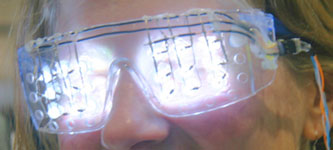 When your visual cortex tries to make sense of an unusual stimulus, it gets very creative. These glasses flash 18 bright white leds into the wearer's closed eyes, causing hallucinations. Most people see a lot of colors and patterns, such as spiraling kaleidoscopic lights, nets, checkerboards, and cross or butterfly shapes. Many people also find it mood altering, usually calming and refreshing but in some cases annoying. Just about everyone is surprised by how strong the hallucinations are. When your visual cortex tries to make sense of an unusual stimulus, it gets very creative. These glasses flash 18 bright white leds into the wearer's closed eyes, causing hallucinations. Most people see a lot of colors and patterns, such as spiraling kaleidoscopic lights, nets, checkerboards, and cross or butterfly shapes. Many people also find it mood altering, usually calming and refreshing but in some cases annoying. Just about everyone is surprised by how strong the hallucinations are.
I made these glasses a couple years ago after seeing a similar device used in the excellent documentary How Art Made the World. The topic was cave painting, and specifically how cave paintings incorporate geometric patterns that look just like the hallucinations brought on by sensory deprivation. It's theorized that the very first artists were recreating the hallucinations they'd had in the dark inner reaches of caves. The narrator went to a neuroscientist who explained how sensory deprivation induces trances and hallucinations, and that a similar effect could be acheived through the use of bright flashing lights. The machine he used for demonstration looked simple enough to replicate, so I made my own. I brought it to Maker Faire this year as an afterthought. To my surprise, Flashy Glasses were the hit of the table, with a constant line of people wanting to try them, and many people coming back for more.
Not long after making Flashy Glasses, I met Mitch Altman, whose "Brain Machine" makes use of the same effect. The Brain Machine uses a programmed combination of light and sound, sychronized to appropriate brainwave frequencies, as an aid to meditation. The Flashy Glasses, by contrast, are much brighter, with knobs to control the flashing directly. I find that the visual effect is much stronger with the Flashy Glasses' brighter lights, and the knobs let me tune the flashing to get exactly what I want. The Brain Machine has the relative advantages of incorporating sound and using a more sophisticated controller to take the user through preprogrammed sequences. You can find instructions for building it in Make magazine, and Mitch does occasional workshops. If you'd rather have knobs and bright lights, check back here in a couple days. I'll be posting some detailed photos of the Flashy glasses and a schematic for the circuit.
| 
